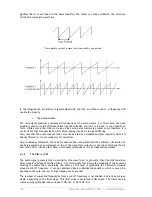
ARTURIA – MOOG MODULAR V – USER’S MANUAL
91
Scale
: Sets the scale frequency
Amount of Shift
: Sets the frequency transition
Mix
: Mix between the positive and negative translations
Mixed output
: Mix of negative and positive translations output connection jack
Positive output
: Positive translation output jack
Negative output
: Negative translation output jack
FM Input
: Frequency modulation connection jack
Audio Input
: Input signal connection jack
This module is used for a linear translation of the frequencies contained in the input signal. Because
of this linearity, the initial harmonic relations are totally modified.
It is easy with this module, to produce metallic sounds.
There are three available outputs: two for each of the translations possible (negative and positive),
the other for a mix of the two, the mix is set with the “Mix” button.
The translation rate, which is to say the difference in frequencies, is set with the “frequency” but-
ton. Following the selected scale (“scale” selector), the button will give a different gap. The scale
also influences the amplitude and type of modulation.
In the exponential position, the translation goes from 2 Hz to 1024 Hz, the modulation being expo-
nential. In the other positions (5,50,500,5k), the translation will be of a maximum of 5 Hz, 50 Hz,
500 Hz or 5000 Hz, in positive or negative.
5.2 SECOND
SECTION
5.2.1 Description
The second section of the Moog Modular V regroups all of the effect modules and the sequencer.
The outputs and inputs of this page needing connections with the modules of the first section are
moved to the latter, in a small extension.
This section contains a module for equalization through a bank of resonant filters, a chorus module,
a phaser, a stereo delay module, and a type 960 sequencer.
The 3 effect modules, filter bank, chorus and stereo delay are applied to the signal of the output
amplifiers in function with the interrupters “vca1” and “vca2”. They are applied in the predefined
order.
The choice between the chorus and the phaser is done through a menu displayed by clicking on the
name of the module.
Summary of Contents for Moog Modular V
Page 1: ...USER S MANUAL Moog Modular V 2 ...
Page 4: ......
Page 8: ......
Page 18: ...18 ARTURIA MOOG MODULAR V USER S MANUAL ...
Page 52: ...52 ARTURIA MOOG MODULAR V USER S MANUAL ...
Page 85: ...ARTURIA MOOG MODULAR V USER S MANUAL 85 Independent mode Parallel mode Serial mode ...
Page 102: ...102 ARTURIA MOOG MODULAR V USER S MANUAL ...
















































